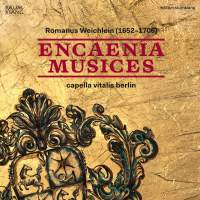Texte paru dans: / Appeared in: |
|
|
Outil de traduction ~ (Très approximatif) |
|
|
Reviewer: Bertil
van Boer Pater Romanus Weichlein (1652–1706) is one of the myriad Benedictine monks who wrote copious amounts of music for performance in their monasteries but who are little known outside in the world. Born in Linz, Weichlein entered into the abbey at Lambach at the age of 19 and was immediately transferred to the University of Salzburg, one of the central educational institutions for the Benedictines. The Kapellmeister there, Heinrich Biber, turned out to be a major influence, and as a violinist, Weichlein no doubt spent much of his studies performing either Biber’s eclectic music or under the master’s direction. In 1687, after a couple of years in Lambach, he was transferred to several cloisters, beginning with the Nonnberg, eventually landing in the Tyrol. His professional life was vibrant, but his personal life was a bit of a shambles, with continual letters confessing various unidentified sins (and perhaps in a cloister as the chief and possibly only male he was subject to temptation), including a rumor that had him allegedly murdering his cook. To be fair, however, he pled self-defense, since the cook, herself perhaps more quarrelsome and fond of liquor, had attacked him with an axe. He finally wound up as a parish priest in the wilds of Hungary. The muddle of his life as a monk seems diametrically opposite to that of his career as a musician, and he achieved a considerable reputation both as a performer and composer in monastic circles. Most of his numerous Masses have been lost, and only a few sacred works survive. There exist, however, two published collections of music. The first is the Encaenia Musices recorded here, and in 1702 there appeared a group of various sacred pieces under the title Parnassus ecclesiastico-musicus. The latter is clearly a didactic work, but the former (and a “posthorn” canon that appears in a strange copperplate engraving) is evidence of his close connection with Biber. The Encaenia is a collection of instrumental works for five-part strings (two violins and two violas, not the modern disposition), to which on occasion have been added a pair of high clarino trumpets. In addition, there is an appendix with some duets for the latter, sort of a fanfare appendix (three of which are recorded here). The works, titled sonatas, are written in a sort of mosaic style, which the composer notes allows for each movement to be “clothed” differently, as he stated in his preface. The music therefore is somewhat flexible, but the static flow of introduction, bass ostinato, and final free-form finale are all typical of the period and allow for continuity if performed en suite. The virtuoso nature of particularly the pieces using the ground bass reflects the advanced art of the Austrian violinist. The moods of the works vary considerably. For example, the opening of the Sonata VII is lugubrious and quite Corellian, with a marching Presto that interrupts the funereal sounds. A brief dance follows, to be replaced by what sounds like a choral music paraphrase, only to end with a return of the lament. If one wishes to place a program to this work, it would be somewhat easy to do. In the Sonata XI, the sonorous introduction is followed by a canon that might be more at home with Johann Pachelbel, and the latter variations trip right along with dancing dotted rhythms. The Sonata III, the longest of the recording, begins with cascading violin figures, cadenza-like, that fold together in chords before expanding out in a broad passacaglia duet between the violins that sounds like a perpetual motion machine. There is a hint of counterpoint here, and the repetitions are almost a throwback to the Italian style of earlier in the century (think a long Biagio Marini). In the Sonata I, the strings open with a fanfare that is taken up by a pair of clarini, which rock along as added filler to the soundscape. As for the other pieces, the four-violin canon of the posthorn signal above an ostinato bass sounds almost otherworldly, marching along with flourishes that twine about each other like the echo of alphorns in the mountains. One can easily imagine hiking along some trail hearing these calls echoing from peak to peak. The clarino duets are brief interludes, marked pro tabula, or for the table. One can see this heralding the arrival of culinary dishes for the abbots (though perhaps not from Weichlein’s unfortunate cook). The performance by the Capella Vitalis is crisp and clean. The clarino duo is remarkably precise on the valveless instruments and appropriately full. The string ensemble work is quite unified, with good tempos and a remarkably sonorous blending in which all are equals. This is an excellent recording of music that is rare and shows that the monastic composers of that age were both progressive and interesting musically. This is one disc that should be part of a collection if one likes the work of Biber, as it shows that this style was more far-reaching than one might imagine. | |
|
|
|
|
Cliquez l'un ou l'autre
bouton pour découvrir bien d'autres critiques de CD |
|




